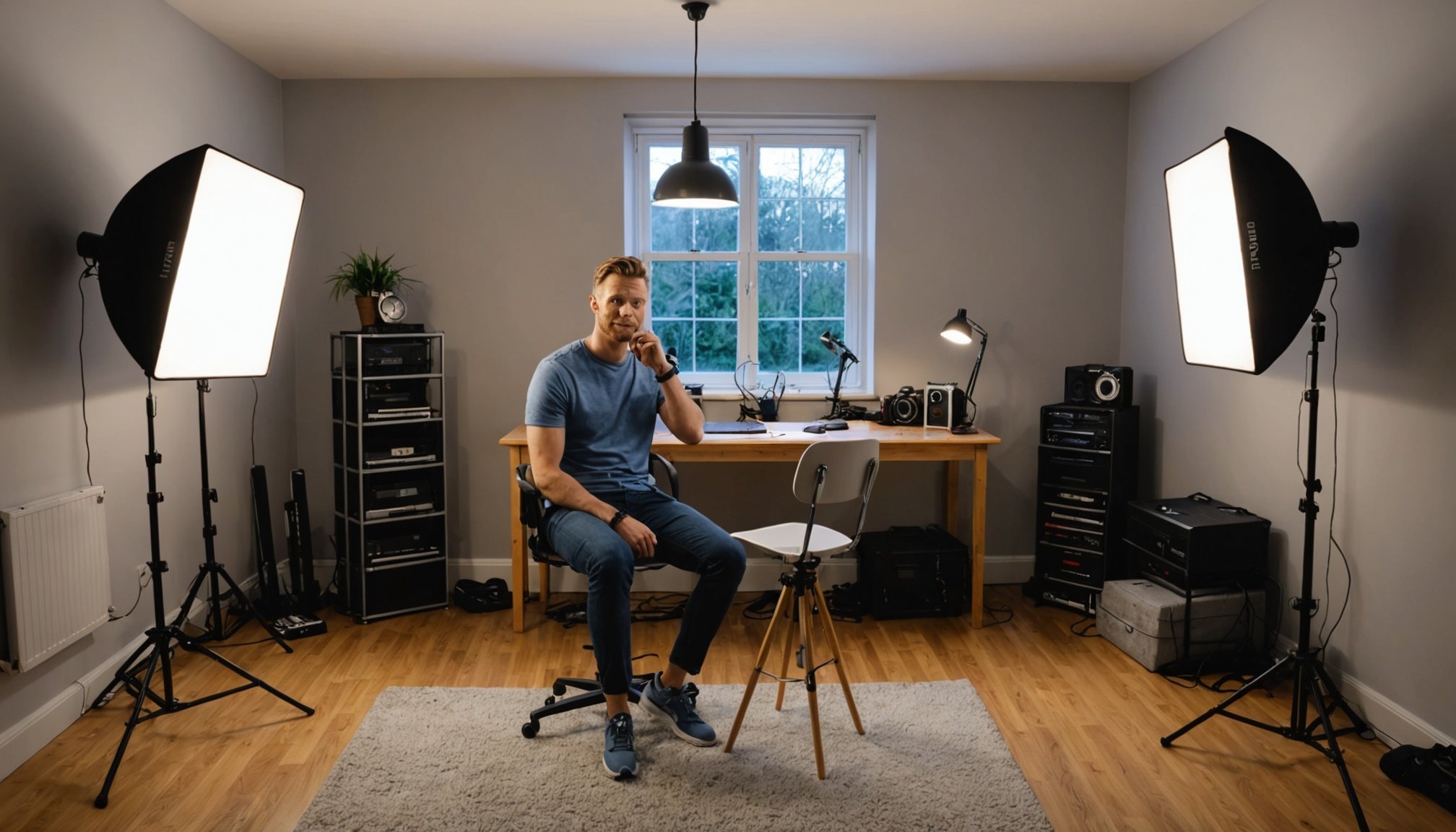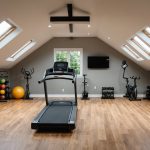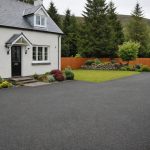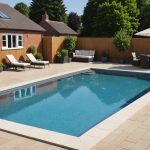Ultimate Guide to Perfecting Your Vlogging Lighting Setup in a UK Home Studio
When it comes to creating high-quality video content, whether you’re a seasoned vlogger or just starting out, the lighting setup in your home studio is crucial. Proper lighting can make or break the visual quality of your videos, and with the right tools and knowledge, you can achieve professional-looking results even in the comfort of your own home.
Understanding the Basics of Video Lighting
Before diving into the specifics of setting up your lighting, it’s essential to understand the basic principles of video lighting. Here are a few key concepts to keep in mind:
A voir aussi : Top Anti-Slip Flooring Solutions for Wet Areas in UK Homes: Safety and Style Combined
Key Light
The key light is the primary light source in your setup and is usually positioned to illuminate your subject’s face. It helps to create a natural-looking highlight and shadow pattern.
Fill Light
The fill light is used to soften the shadows created by the key light. It is typically placed on the opposite side of the key light and at a lower intensity.
A voir aussi : Discover the Benefits of Induction Cooktops for Urban Living in UK Apartments
Backlight
The backlight separates your subject from the background by creating a highlight along the edges of their hair and shoulders. This helps to add depth to your video.
Background Light
The background light is used to illuminate the background of your scene, preventing it from looking too dark or flat.
Choosing the Best Video Lights for Your Setup
Selecting the right video lights can be overwhelming, given the numerous options available. Here are some factors to consider and some top recommendations:
Power Supply
Look for lights that can be powered by both mains and batteries for maximum versatility. The Neewer MS60C, for example, can run off either mains or battery power, making it highly flexible[2].
Color Temperature
A wide color temperature range is preferable. The Godox ML60II Bi, for instance, offers a range from 2800K to 6500K, allowing you to match various ambient light conditions or create specific effects[1].
Modifiers
Check if the light comes with modifiers like diffusers or filters. The Neewer RGB62 includes a diffuser to soften the light and color filters to change the light’s color temperature[2].
Flicker-Free
Ensure the light is flicker-free to maintain constant brightness. Most high-quality video lights, such as those from Zhiyun and Godox, are designed to be flicker-free[1].
Top Video Lights for Vlogging
Here are some of the best video lights that you might consider for your vlogging setup:
Zhiyun MOLUS X60
- Compact and Portable: Ideal for content creators who move around a lot.
- Bluetooth Connectivity: Can be controlled via the ZY Vega app to adjust colors and intensity.
- Color Sampling: Allows you to sample the color temperature of your location and adjust the LED accordingly[1].
Godox ML60II Bi
- Bi-Color LED: Offers a color temperature range of 2800K to 6500K.
- Video Effects: Includes 11 video effects that cycle between the color temperature range.
- No Hue Adjustment: Limited to color temperature adjustments, no full color-based effects[1].
Neewer RGB62
- Affordable and Compact: Super affordable at $26 and highly portable.
- RGB Capabilities: Offers a wide color temperature range of 2500K to 8500K.
- App Control: Can be controlled via the Neewer app, including music synchronization and effects[2].
Setting Up Your Lighting Kit
Here’s a step-by-step guide to setting up your lighting kit for optimal results:
Step 1: Position Your Key Light
Place your key light at a 45-degree angle to your subject’s face, slightly above eye level. This will create a natural highlight and shadow pattern.
Step 2: Add Your Fill Light
Position your fill light on the opposite side of the key light, at a lower intensity. This will help soften the shadows and create a more even lighting.
Step 3: Use a Backlight
Place a backlight behind your subject to separate them from the background. This can be a smaller light or even a hair light.
Step 4: Illuminate the Background
Use a background light to add depth to your scene. This can be a softbox or a panel light placed behind your subject.
Using Ring Lights for Vlogging
Ring lights are particularly useful for vloggers, especially those who frequently film on their smartphones or work in the beauty industry.
Benefits of Ring Lights
- Even Lighting: Ring lights produce a nice, even light that brings out the subject’s eyes.
- Portability: They are often compact and easy to carry around.
- Adjustability: Many ring lights come with adjustable brightness and color temperature settings[4].
Neewer RP18B Pro
- Fixed Color Temperature: The ring light itself has a fixed color temperature unless you use filters.
- Mini Tripod: Comes with a mini tripod that can turn into an extended camera grip, perfect for switching between studio and on-the-go shooting[2].
Tips for Achieving High-Quality Lighting
Here are some practical tips to ensure your lighting setup is top-notch:
Use Natural Light When Possible
Natural light is always the best option if available. Position your setup near a window to utilize natural light, but make sure it’s not too harsh or unflattering.
Invest in a Lighting Kit
A good lighting kit can make a significant difference. Look for kits that include multiple lights and modifiers to give you more flexibility.
Experiment with Different Settings
Don’t be afraid to experiment with different lighting setups and effects. This will help you find what works best for your specific needs.
Consider the Color Temperature
The color temperature of your lights can greatly affect the mood and look of your videos. Warm lights (around 2800K) can create a cozy atmosphere, while cool lights (around 6500K) can make your video look more professional.
Table: Comparison of Top Video Lights
| Light Model | Power Supply | Color Temperature Range | Modifiers Included | Flicker-Free | Bluetooth/App Control |
|---|---|---|---|---|---|
| Zhiyun MOLUS X60 | Mains & Battery | Adjustable via App | Diffuser | Yes | Yes |
| Godox ML60II Bi | Mains & Battery | 2800K – 6500K | Filters | Yes | No |
| Neewer RGB62 | Battery | 2500K – 8500K | Diffuser, Filters | Yes | Yes |
| Neewer MS60C | Mains & Battery | Adjustable via App | Diffuser, Filters | Yes | Yes |
Quotes from Experts
- “Using the best video lights will instantly lift the visual quality of your content, whether you’re recording footage or streaming live. While natural light is totally unpredictable, these devices will create a consistent and pleasing light for your subject.”[1]
- “A good lighting kit can make a significant difference in the quality of your videos. It’s not just about having a lot of lights, but also about having the right lights and knowing how to use them effectively.”[4]
Common Mistakes to Avoid
Here are some common mistakes to avoid when setting up your lighting:
Inconsistent Lighting
Ensure that your lighting is consistent across all shots. Avoid changing the lighting setup mid-shoot unless it’s intentional for a specific effect.
Harsh Shadows
Use fill lights to soften harsh shadows created by your key light. This will help create a more even and flattering lighting.
Insufficient Background Lighting
Don’t neglect the background. Properly lighting the background can add depth and make your video look more professional.
Setting up the perfect lighting for your vlogging studio involves a combination of understanding the basics of video lighting, choosing the right equipment, and experimenting with different setups. Here are some final tips to keep in mind:
- Invest in Quality Lights: While it might be tempting to go for the cheapest option, investing in high-quality lights will pay off in the long run.
- Experiment and Adjust: Don’t be afraid to try different lighting setups and adjust as needed.
- Use Natural Light: Whenever possible, use natural light to add a touch of realism to your videos.
- Keep it Simple: Start with a basic setup and gradually add more lights and modifiers as you become more comfortable with your equipment.
By following these guidelines and tips, you can create a professional-looking lighting setup in your home studio that will elevate the quality of your videos and make them more engaging for your audience.
Practical Insights and Actionable Advice
Setting Up for Video Conferencing
If you also use your setup for video conferencing, make sure your key light is positioned to illuminate your face clearly. A ring light can be an excellent choice for this purpose as it provides even lighting and reduces shadows.
Using Mirrors for Soft Lighting
If you don’t have a fill light, you can use a mirror to reflect some of the key light onto your subject’s face. This can help soften the shadows and create a more natural look.
Creating a Home Studio
When setting up your home studio, consider the background. Use a backdrop or a well-lit background to add depth to your videos. Avoid cluttered or distracting backgrounds that might take away from the focus on your subject.
By incorporating these tips and insights into your lighting setup, you can ensure that your videos look professional, well-lit, and engaging, whether you’re vlogging, streaming, or participating in video conferencing.






